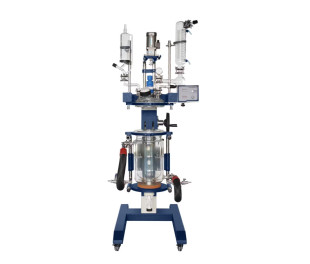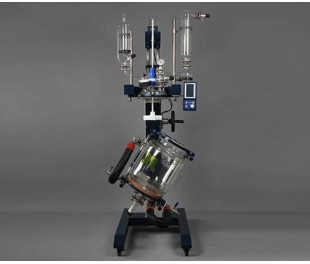Glass Reactors
Glass Reactors for Controlled Chemical Synthesis
Running a multi-step synthesis or crystallization process requires equipment that won't contaminate your product or fail under thermal stress. Borosilicate glass reactors give you the chemical inertness and temperature resistance needed for demanding research work, from pharmaceutical development to catalyst screening.
Chemical Synthesis in Jacketed Glass Reactor Systems
Jacketed designs let you maintain precise temperature control throughout your reaction cycle, whether you're running exothermic condensations or low-temperature lithiations. The double-wall construction connects directly to Circulating chillers and heaters for thermal fluid flow, giving you -80°C to +200°C working range. Real-time visibility through clear borosilicate walls means you can catch precipitation events, color changes, or phase separations the moment they happen—something you'll never get with metal pressure vessels.
Multi-Port Vessel Design Capabilities
Standard configurations include:
- Center neck for overhead stirring or reflux condensers
- Side ports accepting thermometer adapters, addition funnels, or sampling valves
- Bottom drain valves for product transfer without disassembly
- Standardized ground glass joints (24/40, 29/42) compatible with Claisen adapter assemblies for splitting vapor streams
Temperature Jacket Circulation Methods
Connect your jacket inlet and outlet to a temperature control unit using reinforced silicone tubing rated for thermal fluids. Counterflow circulation—inlet at bottom, outlet at top—prevents air pockets that create hot spots. For cryogenic work below -40°C, use ethanol or specialized heat transfer fluids rather than water-glycol mixtures. Always verify your circulator's flow rate matches jacket volume for efficient heat exchange, typically 2-3 liters per minute for 5-10L reactors.
Stirring and Reflux Configuration Options
Overhead mechanical stirring handles viscous slurries and heterogeneous mixtures that defeat magnetic stir bars. PTFE-coated impellers resist chemical attack while providing torque for suspensions up to 50,000 cP. Installing a reflux condenser in the center port captures volatile solvents—after workup, transfer reaction mixtures to Rotary evaporators for solvent removal under vacuum. Vacuum-rated reactor designs withstand down to 1 mbar, suitable for distillations and degassing procedures without external autoclaves.
Our partners
We only work with trusted brands
Sign up to our newsletter to get the latest news and updates about our products.










